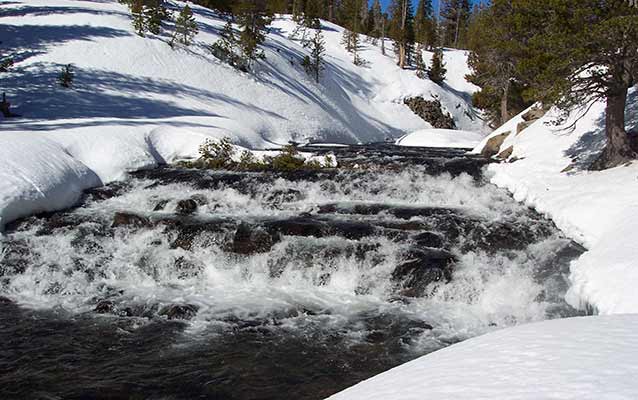Last updated: September 29, 2022
Lesson Plan
Climate Science in Focus (Weather versus Climate)

- Grade Level:
- High School: Ninth Grade through Twelfth Grade
- Subject:
- Science
- Lesson Duration:
- 60 Minutes
- Common Core Standards:
- 6-8.RST.1, 6-8.RST.2, 6-8.RST.4, 6-8.RST.9, 9-10.RST.1, 9-10.RST.2
- State Standards:
- Next Generation Science Standards
HS-LS2-6
Essential Question
What's the difference between weather and climate?
Objective
Students will be able to:
1. Compare and contrast weather and climate.
2. Predict the effects of climate change on life.
Background
In “Climate Science in Focus (Weather versus Climate),” students will explore the differences between weather and climate and how changes in the environment can impact the local climate. Broken into eight days, these lessons require 58 minutes to complete. Designed around 9th grade Next Generation Science Standards, it is a unit easily adapted down for middle school or up for advanced high school classes. Teach the entire unit or pull out particular activities. This is lesson 2 of the unit.
The Earth consists of four systems: the atmosphere, hydrosphere, geosphere, and biosphere, which are interconnected. Changes to one part of the system can have consequences on the others. Changes to global or regional climate can be caused by changes in the sun's energy output or Earth's orbit, tectonic events, ocean circulation, volcanic activity, glaciers, vegetation, and human activity.
Water is essential for life on Earth. Relative water availability is a major factor in designating habitats for different living organisms. In the United States, things like agriculture and water rights are hot topics. Current models predict that average global temperatures are going to continue to rise even if regional climate changes remain complex and varied. These changes will have an impact on all of Earth's systems.
Studies have shown that climate change is driven not only by natural effects but also by human activities. Knowledge of the factors that affect climate, coupled with responsible management of natural resources, are required for sustaining these Earth systems. Long-term change can be anticipated using science-based predictive models, making science and engineering essential to understanding global climate change and its possible impacts.
National Parks can serve as benchmarks for climate science trends and effects over time because they are protected areas void of human influence. Understanding current climate trends will help set students up to be successful in interpreting and engaging in discussions about climate change, which will lead to informed decision making.
Preparation
Most of the materials for this unit are provided in the Stream Flow River Study Trunk or as downloadable files.
Video Earth: Climate and Weather
http://video.nationalgeographic.com/video/science/earth-sci/climate-weather-sci/
Video Time Lapse, Soda Springs Meadow October 2012-September 2013
https://www.youtube.com/watch?v=Lwekowxh4To
Materials
3 slide power point for teacher instruction.
Download Climate and Animals Presentation
Directions for students "Carry Capacity"
Venn Diagram for comparing weather and climate
Procedure
Step 1
Distribute the Do Now- How do animals adapt to their climate?
Step 2
1. Show the video Earth: Climate and Weather. http://video.nationalgeographic.com/video/science/earth-sci/climate-weather-sci/
2. Monitor students as they complete a Venn diagram showing similarities and differences between weather and climate Worksheet 2.1
Step 3
1. Have students brainstorm: What changes can be observed during different seasons? (plants, animals, weather, water, daylight, temperature, …) Guide brainstorming activity. Record list or have volunteer record.
2. Lecture/Notes: Presentation to define morphological, physiological, and behavioral traits of animals. Students should record notes and participate in class discussion.
Step 4
1. Carrying capacity bucket demo. Procedure 2.1
Assign task: In three paragraphs, in your own words, describe carrying capacity. (Intro, Body, Concl.)
Vocabulary
weather, climate, atmospheric circulation, climate change, feedback loops, physical process, chemical process, carrying capacity, morphological, physiological, behavioral traits, adaptation, redistribution
Assessment Materials
Exit Ticket
Distribute exit ticket – Based on what you know about traits of animals, predict some of the effects of climate change on animals.
Supports for Struggling Learners
Give students who are struggling one point in each circle of the Venn Diagram. This will allow them to see an example of the types differences between weather and climate that are desired. Or an alternate unrelated example can be used to model.
Related Lessons or Education Materials
Other Lessons from this Unit
Day 1- Earth as a System
Day 2- Weather vs Climate
Day 3- Watershed
Day 4- Climate Science Data and Tools
Day 5- Field Trip
Day 6- NPS Connections
Day 7- Project Preparation
Day 8- Evaluations
